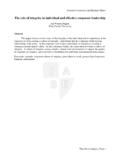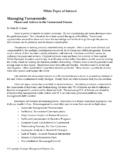Transcription of Managing Value Chain Strategy - AABRI
1 Journal of Management and Marketing Research Managing Value Chain Strategy Peter H. Antoniou California State University San Marcos Catherine E. Levitt California State University at Los Angeles Cynthia Schreihans California State University San Bernardino ABSTRACT. The urgency and immediacy of the current financial crisis that burst into American consciousness in the 4th quarter of 2008 has left companies around the world gasping for air. This situation presents a need to review the meaning of sustainability in an increasingly turbulent environment. Therefore, this article presents a review of the meaning of sustainability in an increasingly turbulent environments, and it seeks to present a working model for evaluating the impact of autonomous and non-autonomous elements of the Value Chain as they relate to, outsourcing in accordance to corporate Strategy .
2 While there is much discussion, both academic and practical, about the strategic advantage sought through outsourcing and, equal discussion about the process of making the decision to outsource, little has been done to examine how best to use the outsourcing Value Chain . Successful and poor outcomes of outsourced processes have been reported. To date however, no model has been developed to improve the possibility of surviving an economic crisis and replicating success with outsourcing. Both small and medium sized enterprises that are engaged in outsourcing seek better utilization and better management of the components of the Value Chain during turbulent economic conditions. Benefits from the utilization of the presented model and the information contained in this document will better assist in associated process development.
3 Keywords: Value Chain Model, Outsourcing, Financial crisis , Corporate Sustainability CONCEPT INTRODUCTION. The urgency and immediacy of the current financial crisis that burst into American consciousness in the 4th quarter of 2008 has left companies around the world gasping for air. The question of strategic success for large and small firms has shifted from one based on profit growth to one of survival. This presents a need to review the meaning of sustainability in an increasingly turbulent environment. This paper seeks to present a working model for evaluating the impact of autonomous and non-autonomous elements of the Value Chain on the corporate Strategy of small and medium sized enterprises engaged in outsourcing. The model leans toward better utilization and better management of the components of the Value Chain under turbulent economic conditions.
4 This model derives its theoretical basis in the juxtaposition of the literature that supports Value Chain dynamics with that which finds Value Chain lacking essential measurable standards While there is much discussion, both academic and practical, about the strategic advantage sought through outsourcing and, equal discussion about the process of making the decision to outsource, little has been done to examine how best to manage the outsourced Value Chain . Both successful and poor outcomes of these outsourced processes have been reported, but no model has been developed to improve the possibility of surviving the crisis and replicating success. This paper and model seeks to fill these voids. With this model, the channels of information, communication, authority and factors resource which structure of the Value Chain are examined.
5 The differences in flows through each component may be evaluated so that the relationships between components (and between the components and the enterprise) are more clearly seen. The balance between competition and collaboration within the Chain is calibrated for external turbulence and internal aggressiveness producing affects, which then are aligned with the strategic position of the enterprise. With this alignment, the fragmentation of the applications of Strategy is reduced, relationships between components become more transparent and the possibility of replicating or innovating successful practice is increased, even in the throes of this current crisis . Use of this model in the strategic process should enable the small or medium-sized enterprise to answer the following questions: Are the participants in the Value Chain part of our Strategy design and application?
6 Are we participants in their Value Chain ? Are we treating the Value Chain participants as SBU's or SBA's? Do our Value Chain participants affect our encounter with the external environment? How do we affect theirs? Does participating in this Value Chain change our organizational structure and decision making? How should the Value Chain be managed and by whom? Are we responsible for the Value Chain or dependent on it? Value Chain . The Value Chain is a systematic approach to examining the development of competitive advantage and was created by M. E. Porter in his books on Competitive Advantage (1980 and 1985). The Chain consists of a series of activities that create and build Value . They culminate in the total Value delivered by an organization.
7 The margin' depicted in the diagram as indicated in Managing the Value Chain , Page 2. Table 1 (Appendix A) is the same as Value added. The organization is split into primary activities' and support activities'. Essentially, this was a way of examining the Value added by both direct and indirect departments or by both cost and profit centers. Current texts for Strategic Management explain that 20 years after the conception of Value Chain analysis, US firms faced increased competition at all levels (Fred ; Dess, Lumpkin nd Eisner, Hill and Jones, Hitt and Ireland, Peng, Thompson and Strickland). While in the 80's, no two companies were at the same level of competition. Where the original motive of firms was increased production, by the change of millennium, the main motive had become customer service.
8 Products were increasingly differentiated closer and closer to customer. The original reactive approach of industries was replaced by an active/proactive approach. These approaches are depicted in the diagram as indicated in Table 2 (Appendix B): Expansion of the Relevant Environment. Customers, also, evolved during these 20 plus years. Where customers had had relatively little market power and limited interest in product specifications, by the beginning of the 21st century, customers had become increasingly sophisticated, increasingly interested in specifications, and more powerful. This expanded understanding of companies and markets through Value Chain analysis led to the increasing use of outsourcing in both the primary and support and primary activities.
9 All of this was intended to increase Value for the increasingly important and powerful customer while decreasing the costs to the organization. By 1999. Charles Leadbetter's, Living on Thin Air' suggests that ideas rather than products were the sole and central generation of Value . At the same time, there was an increasing assumption that products needed to be inexpensive to be valuable, but that idea generation (Human Capital ). (Peng, 2009, Hitt and Ireland, 2009, and Thompson and Strickland, 2010). A recent survey of the main usages inputs labor, entrepreneurship and knowledge). should be highly rewarded. Possible as long as development funding was readily available through a combination of debt and equity financing. The relative ease of attracting financing and the rewards for outsourcing again changed the weight that Value Chain analysis held and the way it was done ( McNair,, Polutnik and Silvi 2001; Sanjiv (2002).
10 By 2005, Strategic Management texts were carrying a caveat that Value Chain analysis was useful and accurate when applied to production based organization but less accurate and less than effective in examining service producers and idea generating firms. The current financial crisis and the failure of firms to recognize its advent, demands that a new look be taken at the generation of Value . Value Chain analysis and evaluation offers a starting point of the term Value in economics, marketing, Strategy and operations fields indicates that the notion of Value Chain may be a misnomer, although a widely used one. According to this analysis, only resources move along the Chain of linkages between firms supplies going one way and money going the other Therefore, Value chains can be thought to operate in both directions, with suppliers accruing Value from financial resources, payment terms, stability and future order cover that their customers provide, while customers derive Value from delivered products and services.














